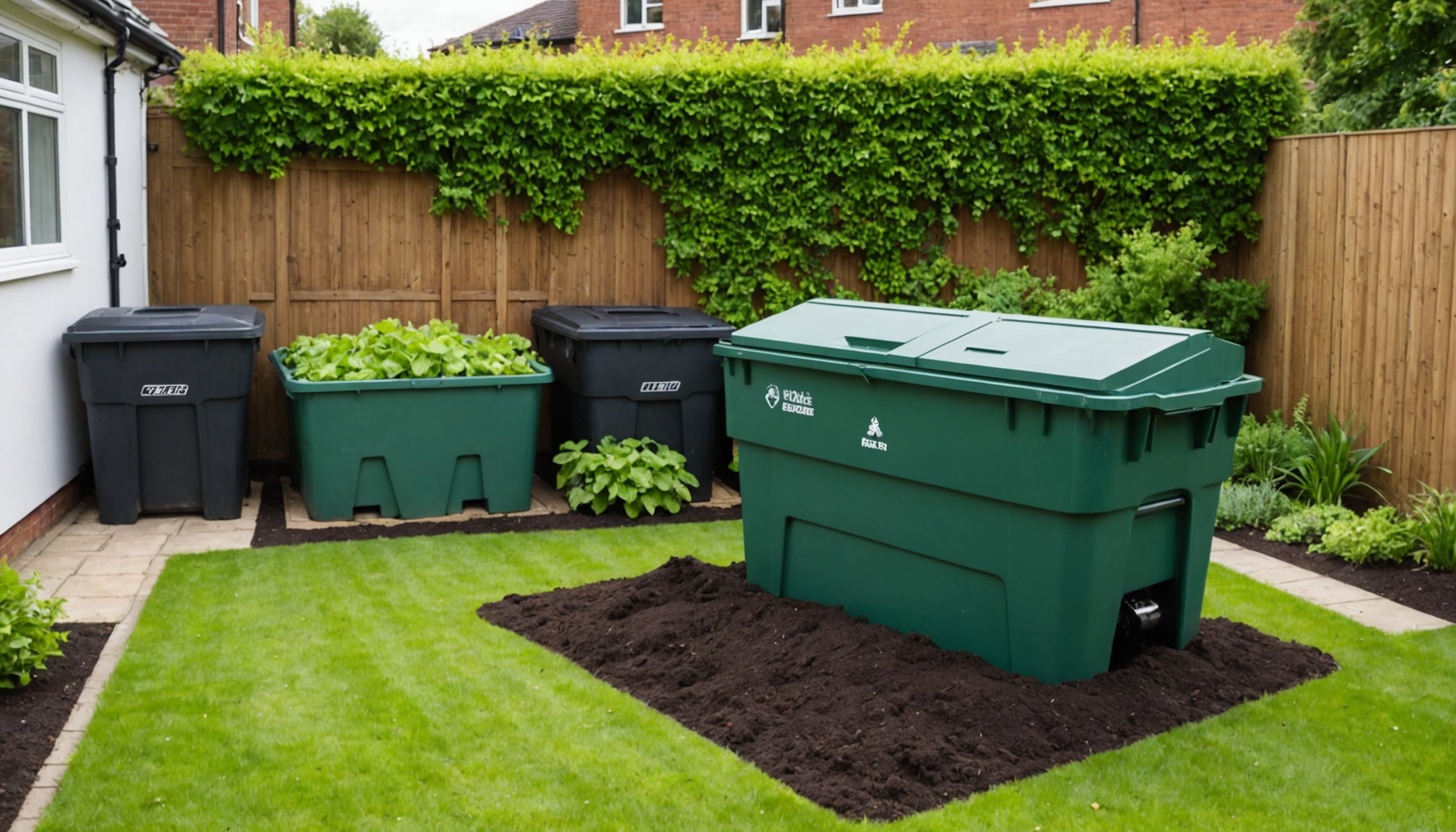Understanding Composting
Delving into composting basics, it becomes evident that this process is not just an activity for avid gardeners; it’s a critical tool for reducing household waste. By transforming organic waste into nutrient-rich soil, composting helps minimise the volume of waste sent to landfills. For homeowners in the UK, this means a significant reduction in their waste footprint, supporting broader environmental goals.
Types of Composting
There are various types of composting systems tailored to different homeowner needs. Traditional composting, often carried out in a corner of the garden, allows organic materials to decompose over time with minimal intervention. Alternatively, vermicomposting uses worms to expedite the decomposition process, offering a more rapid solution for smaller spaces. For those seeking convenience, compost tumblers offer an easy-to-turn alternative that can accelerate the process, fitting well into urban lifestyles.
Additional reading : Essential Tips for UK Homeowners: Creating a Versatile Home Gym for Cardio and Strength Training
Benefits of Composting
Composting offers numerous environmental benefits, especially relevant to the UK. By enriching the soil, it enhances local biodiversity, promotes healthier plant growth, and reduces the need for chemical fertilisers. Moreover, it plays a pivotal role in lowering methane emissions from landfills, tackling one of the harmful greenhouse gases contributing to climate change.
Choosing the Right Compost Bin
To facilitate successful composting, the first step is selecting compost bins that match your needs. Compost bin options come in various designs, offering diverse functionalities suited for different settings.
In parallel : Maximizing Efficiency: A Homeowner’s Guide to Integrating Solar Thermal Panels with Current Hot Water Systems in the UK
Types of Compost Bins
When reviewing compost bin options, consider the typical choices such as tumblers, stationary bins, and worm composters. Tumblers are ideal for quick composting as they allow easy turning of materials. Stationary bins, often larger, suit those with ample space. Worm composters are excellent for small-scale indoor composting.
Factors to Consider When Choosing
While selecting compost bins, size is a critical factor. Compost bin sizes vary, impacting the volume of waste you can process. Assess your available space and the amount of waste you expect to generate. Durability, ventilation, and ease of use are also crucial considerations that influence your composting experience.
Recommended Suppliers
For a quality selection, explore suppliers known for their variety of compost bin options. Retailers like specialized garden centers and sustainability-focused stores often offer diverse selections. Always opt for reputable companies that provide bins designed to withstand varying weather conditions while enhancing composting efficiency.
Waste Types Suitable for Composting
When it comes to composting, understanding the various compostable materials is essential for effective results. Kitchen waste is a primary contributor. Items like vegetable peels, fruit scraps, eggshells, and coffee grounds make excellent additions to your compost heap. These materials are rich in nitrogen, acting as “greens” in the composting process.
Garden waste is another vital component, providing the necessary “browns” that balance the compost pile. Compostable garden waste includes dried leaves, small branches, plant clippings, and lawn trimmings. These materials are rich in carbon, which is crucial for maintaining a healthy compost ratio.
The balance between green and brown materials is critical. Too much kitchen waste can make the pile overly wet, slowing down decomposition, while excessive garden waste can lead to a dry pile lacking the necessary heat and bacteria activity.
Balancing these elements will ensure efficient breakdown and sustain aerobic conditions. Aim for a ratio of roughly 3:1 of browns to greens for optimal composting. With the right materials and balance, your compost will flourish, transforming waste into nutrient-rich soil.
Step-by-Step Guide to Creating a Composting System
Creating a composting system is a rewarding project. Start by selecting a location in your backyard, ideally shaded and easy to access. Make sure it’s near a source of water as moisture control is crucial.
To begin the composting process, gather organic waste such as fruits, vegetables, coffee grounds, and eggshells. It’s vital to have a good mix of ‘greens’ (nitrogen-rich materials) and ‘browns’ (carbon-rich materials like dried leaves and branches). When building a compost pile, layer these materials alternately to ensure balanced decomposition.
Aeration and moisture play significant roles in fermentation. To maintain proper aeration, turn the compost pile weekly with a garden fork, which keeps air circulating and accelerates the breakdown of materials. Manage moisture by ensuring the compost pile is damp but not soaked. The texture should resemble a wrung-out sponge.
For backyard composting steps to be effective, maintain the pile’s temperature. Efficient composting occurs when temperatures reach between 130-150°F. This high temperature helps to kill pathogens and weed seeds, making your compost safe and nutrient-rich for garden use.
Maintenance Practices for a Healthy Compost System
Compost maintenance is essential to creating a thriving and efficient compost system. Regular care ensures that the composting process is effective, leading to nutrient-rich compost for gardening use.
Regular Turning and Mixing
Regularly turning compost is a crucial practice in maintaining the system’s health. Turning compost helps aerate the material, providing oxygen essential for microorganisms to decompose organic matter. Ideally, compost should be mixed every 1 to 2 weeks. This practice aids in maintaining a balanced temperature throughout the pile, promoting even decomposition and preventing unpleasant odours. By ensuring continual access to air, you can cultivate an environment that accelerates the composting process.
Monitoring Moisture Levels
Moisture management plays a significant role in compost maintenance. Compost should be kept damp, resembling a wrung-out sponge. Too little moisture can slow the breakdown process, while excess water can make the compost soggy, reducing airflow and creating unpleasant smells. Using a moisture meter or simply squeezing a handful can help you assess the pile’s dampness.
Troubleshooting Common Issues
Occasionally, you may encounter issues like foul odours or slow decomposition. These can often be resolved by adjusting moisture levels or increasing the frequency of turning compost. Addressing problems early helps maintain compost quality and efficiency.
Addressing Common Challenges in Composting
Composting can be a rewarding but sometimes puzzling endeavour. One common problem is managing unpleasant odors. Often, the culprit is too much green material, leading to excessive moisture. To resolve this, simply add more brown materials like dried leaves or straw to balance moisture levels. Proper aeration is crucial in tackling composting problems related to smell.
Pests can disrupt the composting process, yet they do not need to become persistent nuisances. Troubleshooting compost issues often involves ensuring meat, dairy, or high-fat foods are not in the pile, as they attract unwanted pests. Encouraging beneficial organisms, like earthworms, can aid in natural pest control. These organisms help aerate the compost while breaking down organic material more efficiently.
When compost is breaking down slowly, a few adjustments can be made. Good aeration is key; consider turning the compost heap regularly and using a garden fork to introduce air. Monitoring moisture levels can also prevent matting and compaction, enhancing breakdown speed.
Incorporating these strategies will steadily improve compost quality, resulting in rich, earthy compost without the headaches. Keeping common issues in check helps cultivate a successful composting experience.
UK-Specific Resources and Regulations
Navigating the landscape of composting in the UK requires awareness of both national and local composting policies. Regulations can vary by area, impacting how residents and businesses manage waste. Local authorities are key in providing guidelines on composting practices tailored to their specific communities. Understanding these rules ensures compliance and maximises the environmental benefits.
For those seeking to deepen their composting knowledge, many councils offer workshops and community programs. These initiatives educate the public on best practices and encourage wider participation in composting efforts. Such resources foster community engagement and build a culture of sustainability.
When it comes to UK recycling and composting support, several government websites serve as valuable resources. The UK government’s Department for Environment, Food & Rural Affairs (DEFRA) provides comprehensive information on environmental legislation. Additionally, the Waste and Resources Action Programme (WRAP) offers guidance on sustainable waste management, helping communities optimize their composting efforts.
These regulations and resources are foundational to advancing environmental legislation and sustainable practices across the UK. By engaging with these support networks, individuals and businesses can contribute positively to environmental conservation efforts.
Eco-Friendly Practices for Homeowners
Adopting eco-friendly practices is an essential step towards sustainable living. Homeowners can significantly reduce their carbon footprint by implementing various strategies, such as eco-friendly composting and maximizing food waste diversion.
Utilizing Food Waste Diversion Strategies
To effectively divert food waste, homeowners can use kitchen compost bins to separate compostable materials from regular trash. This method not only manages waste efficiently but also supports eco-friendly composting by utilizing organic waste. Additionally, exploring options like vermiculture or creating backyard compost piles helps maintain a sustainable balance within the household ecosystem.
Engaging with Community Composting Initiatives
Community composting initiatives provide a collective approach to sustainable living. Participating in these programs can facilitate the reduction of a household’s carbon footprint while fostering a sense of community. Local municipalities or online platforms often offer guidance on joining or starting community composting projects, ensuring everyone can contribute to eco-friendly practices.
Tips for Educating Family and Neighbors about Composting
Educating others on sustainable practices can create a ripple effect in reducing the community’s carbon footprint. Sharing resources on eco-friendly composting, conducting demonstrations, or organizing workshops encourages a collective effort. Open discussions and providing simple, relatable examples make the concept accessible for everyone, inspiring them to integrate these practices into their daily lives.
Visuals and Checklists to Enhance Understanding
In today’s eco-conscious world, composting visuals serve as invaluable tools to help individuals grasp composting techniques effectively. These visuals simplify complex processes by breaking them into digestible parts, illustrating each step vividly. Imagine a diagram showcasing how organic waste transforms into nutrient-rich soil – such images make the process accessible to learners of all ages.
In the realm of practical application, composting checklists prove indispensable. They guide users through tasks, such as collecting kitchen scraps or turning the compost pile, ensuring no vital steps are missed. Here’s how checklists can help:
- Confirm all necessary materials like browns (dry leaves, twigs) and greens (fruit peels, grass clippings) are ready.
- Ensure regular maintenance tasks, like balancing moisture levels, are performed.
Educators and enthusiasts can further enhance understanding by leveraging educational materials. Many organizations offer resources for downloadable guides and tutorials, which provide easy reference points. These guides often come in user-friendly formats, with step-by-step instructions supported by visuals and checklists, demystifying the art of composting. Consequently, such materials empower individuals to become adept at composting, fostering a more sustainable environment.











